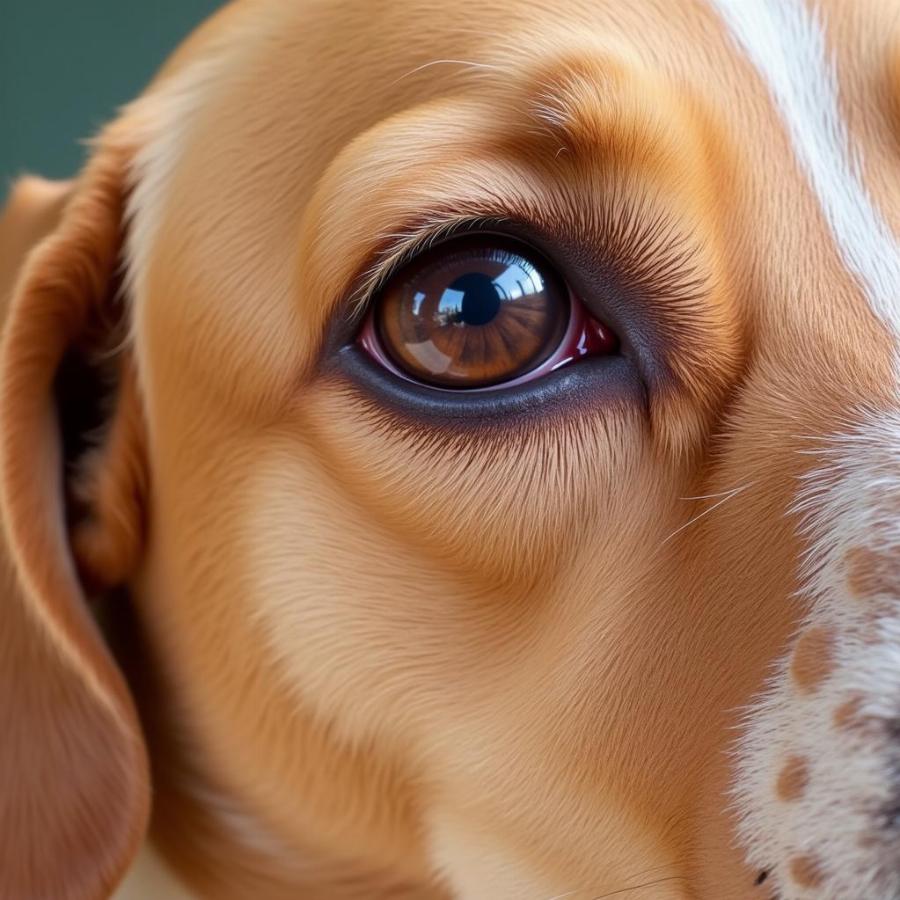Concerned about your furry friend’s peepers? Searching for “pictures of dog eye problems” is a great first step in understanding what might be bothering your canine companion. Just like humans, dogs can experience a variety of eye issues, ranging from mild irritations to more serious conditions. This visual guide will help you recognize common dog eye problems so you can seek veterinary care promptly.
Common Eye Issues in Dogs: What to Look For
While this guide provides a starting point, it’s crucial to remember that a proper diagnosis and treatment plan can only be made by a qualified veterinarian. Let’s delve into some common eye concerns and what they might look like:
Conjunctivitis: The “Pink Eye” of Dogs
Just like in humans, conjunctivitis in dogs often presents as a red, irritated eye. You might notice your dog squinting, pawing at their eye, or having discharge. Conjunctivitis can be caused by allergies, irritants, infections, or underlying health issues.
Cataracts: Clouding the Lens
Cataracts involve a clouding of the eye’s lens, leading to blurry vision and potential blindness. Early cataracts might appear as a slight haze or bluish-gray discoloration in the pupil. As they progress, the pupil may appear completely white.
Cherry Eye: A Prolapsed Gland
“Cherry eye” describes a prolapsed tear gland, where the gland in the third eyelid pops out of place. It appears as a pink or red swelling in the corner of the eye, often resembling a small cherry.
Dry Eye: Insufficient Tear Production
 Dog with Dry Eye
Dog with Dry Eye
Keratoconjunctivitis sicca (KCS), commonly known as dry eye, occurs when the tear glands don’t produce enough lubrication. Symptoms include red, irritated eyes, excessive blinking, and a thick, sticky discharge.
When to Worry: Signs Your Dog Needs Immediate Veterinary Attention
While many eye issues are treatable, some require immediate veterinary attention. Contact your vet immediately if you observe any of the following:
- Sudden blindness
- Visible pain or distress
- Cloudiness or color change in the cornea
- Unequal pupil size
- Bulging of the eye
- Bleeding from the eye
Protecting Your Pup’s Peepers: Tips for Eye Health
Maintaining good eye hygiene is crucial for your dog’s overall well-being. Here are some tips:
- Regularly clean discharge: Use a soft, damp cloth to gently wipe away any discharge from your dog’s eyes.
- Grooming: Keep the fur around your dog’s eyes trimmed to prevent irritation.
- Prevent eye injuries: Use a harness instead of a collar to reduce pressure on your dog’s neck and eyes, especially during walks.
- Regular vet checkups: Schedule annual eye exams, especially for senior dogs or breeds prone to eye problems.
FAQ: Common Questions About Dog Eye Problems
Q: Can I use human eye drops on my dog?
A: Never use human eye drops on your dog without consulting your veterinarian. Many human medications are not safe for dogs and can cause serious harm.
Q: Are certain dog breeds more susceptible to eye problems?
A: Yes, some breeds, such as Pugs, Bulldogs, Shih Tzus, and Cocker Spaniels, are more prone to certain eye conditions due to their facial structure or genetics.
Q: Can diet impact my dog’s eye health?
A: A balanced diet rich in antioxidants and omega-3 fatty acids can support overall eye health. Talk to your veterinarian about the best food choices for your dog.
Looking for More Information?
Check out these related articles for more insights:
Beaut Dogs: Your Trusted Resource for Canine Care
Beaut Dogs is your go-to source for all things related to caring for your canine companion. We provide reliable, expert-backed information on various dog breeds, health concerns, training tips, and much more. If you need personalized advice or have questions about your dog’s eye health, don’t hesitate to reach out to us at [email protected]. Let us help you keep your furry friend happy and healthy!